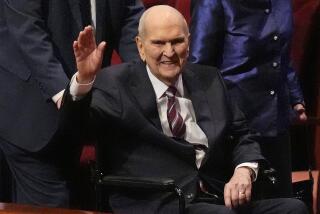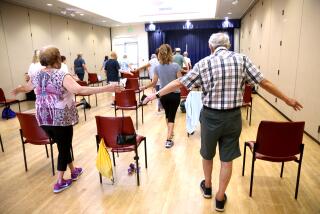Birthdays: A Fading Fad in Aging Land? : Culture: Concern about age is a 20th Century thing. It may be on the way out, a historian says.
- Share via
Contemporary Americans are living longer than their ancestors, yet they seem more obsessed about age and aging.
Look in any greeting-card shop for evidence. Row upon row of birthday cards offer congratulations to people in every age group, from newborns to 90-year-olds. Cards for people reaching their 40th birthdays abound as the baby boom generation matures.
It wasn’t always so. Growing old was nothing to celebrate in the past, said Dr. Gene Cohen, deputy director of the National Institute on Aging in Bethesda, Md.
“Today, there is a growing number of people who are aging well,” Cohen said. “Earlier, when large numbers of people did not age well, people expected a traumatic and dismal later life.”
In fact, the tradition of birthday celebrations is only about 100 years old, according to Howard P. Chudacoff, a history professor at Brown University whose book, “How Old Are You?” (Princeton University Press, 1990), traced the evolution of age-consciousness in this country.
Chudacoff, who specializes in urban society, wrote that the first birthday cards, which appeared around the turn of the century, coincided with a growing emphasis on age: It was at this time that schoolchildren first were grouped by age and that pediatrics was established as a medical specialty.
Scientific advances, improved nutrition and changes in demographic patterns as cities developed also enhanced the significance of age, Chudacoff said.
“Death could have come any time in life 200 to 300 years ago,” Chudacoff said in an interview. “Death was part of everyday life. People accepted it. . . . Now we have confined death more to later stages of life.”
Observing one’s birthday became not only a personal milestone, but a way of relating to society.
For trivia buffs, Chudacoff, who is 47, also dated “Happy Birthday,” the most popular song in the American repertoire, to 1934. “Happy Birthday” itself has thus only reached “middle age,” a concept that surfaced after World War I, Chudacoff writes.
The widespread awareness of birthdays and age has its down side, he said.
Ageism is a “discriminatory shorthand for representing certain abilities in society,” Chudacoff said. He called the grouping of individuals according to age “too artificial” as well as unfair.
“Like gender and race,” he wrote, “age cannot be changed. To disadvantage individuals merely because they possess a particular characteristic, one for which they cannot be held morally responsible, offends traditionally American sensibilities of fairness.”
Chudacoff reiterated in the interview that reaching age 65 “does not mean you lose all talents or productivity.”
There are more than 30 million people older than 65 in the United States, Cohen said. “That is more than the population of Canada.”
The fastest-growing age segment of the population is the 85-and-older group. The average life expectancy in this country is about 75 years for men, slightly longer for women.
While Americans remain preoccupied with their individual biological clocks, society’s view of growing old is changing. Chudacoff also believes that age-consciousness may have peaked, that society may be entering an era of “age irrelevance.”
“By the latter part of the 20th Century, Americans had become more sensitive to the consequences of using age as a criterion for social status and as a norm for behavioral expectations,” Chudacoff concluded from his study. “Perhaps, as with racism and sexism, this recognition also represents the peak of age-consciousness in the course of American cultural history.”






